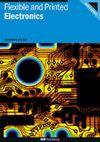Low specific absorption rate quad-port multiple-input-multiple-output limber antenna integrated with flexible frequency selective surface for WBAN applications
IF 3.2
4区 工程技术
Q3 MATERIALS SCIENCE, MULTIDISCIPLINARY
引用次数: 2
Abstract
This paper presents the design and analysis of a multiple-input-multiple-output (MIMO) textile antenna for wireless body area network (WBAN) applications. The MIMO antenna is comprised of four identical modified rhombus-shaped monopole antenna elements of size of 0.57 λ0× 0.57λ0× 0.015λ0 , where λ0 is the wavelength calculated at the lowest operating frequency. The antenna is backed by a 6 ×6 frequency selective surface (FSS) of dimensions of 0.84 λ0× 0.84λ0× 0.015λ0 to improve gain and to reduce specific absorption rate (SAR). The antenna has an impedance bandwidth (S 11 ⩽ −10 dB) of 8.8 GHz (2.8–11.6 GHz) and isolation of >19 dB between the resonating elements. In order to assess the MIMO antenna’s flexibility, the bending analysis is performed for various bending radii. The obtained diversity metrics are: envelope correlation coefficient <0.5 dB, diversity gain <10 dB, channel capacity loss <0.4 bits s−1 Hz−1, and total active reflection coefficient <−10 dB. The performance of the antenna with and without FSS is investigated for gain enhancement and SAR reduction. With the help of FSS, the antenna gain is increased to 8.44 dBi, and the SAR reduced from 6.99 Watt kg−1 to 0.0273 Watt kg−1. The FSS achieves the highest efficiency of 96%. The designed antenna is suitable for smart textile applications due to its low SAR, high gain, and wider impedance bandwidth.低比吸收率四端口多输入多输出柔性频率选择面天线集成无线宽带应用
本文介绍了一种用于无线体域网络(WBAN)的多输入多输出(MIMO)纺织天线的设计与分析。MIMO天线由4个尺寸为0.57λ0× 0.57λ0× 0.015λ0的修正菱形单极天线单元组成,其中λ0为最低工作频率时计算的波长。该天线采用尺寸为0.84λ0× 0.84λ0× 0.015λ0的6 ×6频率选择表面(FSS),以提高增益并降低比吸收率(SAR)。该天线的阻抗带宽(S 11≤−10 dB)为8.8 GHz (2.8 ~ 11.6 GHz),各谐振元件之间的隔离度为> ~ 19 dB。为了评估MIMO天线的柔性,对不同的弯曲半径进行了弯曲分析。得到的分集指标为:包络相关系数<0.5 dB,分集增益<10 dB,信道容量损耗<0.4 bits s−1 Hz−1,总主动反射系数<−10 dB。研究了带FSS和不带FSS时天线的增益增强和SAR降低性能。在FSS的帮助下,天线增益增加到8.44 dBi, SAR从6.99瓦特kg−1降低到0.0273瓦特kg−1。FSS达到96%的最高效率。该天线具有低SAR、高增益、宽阻抗带宽等特点,适合智能纺织应用。
本文章由计算机程序翻译,如有差异,请以英文原文为准。
求助全文
约1分钟内获得全文
求助全文
来源期刊

Flexible and Printed Electronics
MATERIALS SCIENCE, MULTIDISCIPLINARY-
CiteScore
4.80
自引率
9.70%
发文量
101
期刊介绍:
Flexible and Printed Electronics is a multidisciplinary journal publishing cutting edge research articles on electronics that can be either flexible, plastic, stretchable, conformable or printed. Research related to electronic materials, manufacturing techniques, components or systems which meets any one (or more) of the above criteria is suitable for publication in the journal. Subjects included in the journal range from flexible materials and printing techniques, design or modelling of electrical systems and components, advanced fabrication methods and bioelectronics, to the properties of devices and end user applications.
 求助内容:
求助内容: 应助结果提醒方式:
应助结果提醒方式:


